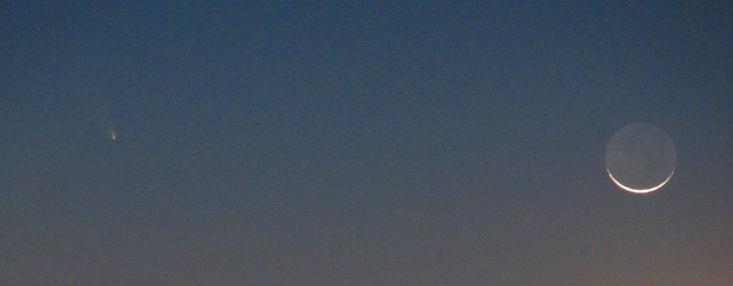March 13, 2013
Comets PANSTARRS and Lemmon at their best
During the Spring of 2013, two comets will be visible to the naked eye.
Comet C/2011 L4 (PANSTARRS) is a bright 1st magnitude object sporting a bright dust tail. The comet reached perihelion at a distance of 0.30 AU from the Sun on March 10th and is currently at its brightest. After spending the last few months only visible from the Southern Hemisphere, the comet is now visible from Northern Hemisphere. Many observers have been able to observe the comet with the naked eye even though it is located at very low elevations against a bright twilight sky. Co-coordinator Carl Hergenrother was able to observe the comet as a faint star with a hint of a 0.1° tail on the evening of March 13 UT when the comet was only 3° above the horizon. Not until April will it be visible against a dark sky. It will become circumpolar by the end of April though it will have most likely faded to a faint naked eye object.

Image of Comet C/2011 L4 (PANSTARRS) and the Moon taken by Robert Lunsford from Chula Vista, CA, USA on the evening of March 12, 2013. The image is a 2-second exposure taken at f/3.5 with a Canon Power Shot S2 IS. Credit: Robert Lunsford.
The other naked eye comet is C/2012 F6 (Lemmon). Recent magnitude estimates place it at magnitude 4.5 to 5.0. With perihelion on March 24 at a distance of 0.73 AU from the Sun, the comet may brighten a few more tenths of a magnitude. CCD imagers find the comet to be gas-rich and appearing strikingly different from dust-rich Comet PANSTARRS. Lemmon is currently a Southern Hemisphere-only comet and will not be visible for northern observers until late April/early May when it emerges in the morning sky. By then the comet should have faded to magnitude 6.
Though not yet of naked eye brightness, the other big comet of the year is the so-called ‘Comet of the Century’, C/2012 S1 (ISON). Whether this comet becomes as spectacular as hoped this coming November/December is still to be seen. This Spring, ISON is well placed in the evening sky for CCD and large aperture visual observation. The comet is currently 15th magnitude. It should continue to brighten to 14th magnitude by the time it gets too close to Sun for easy observation in late May.
The ALPO Comet Section request observations of these and other comets, including images, drawings and magnitude estimates.



